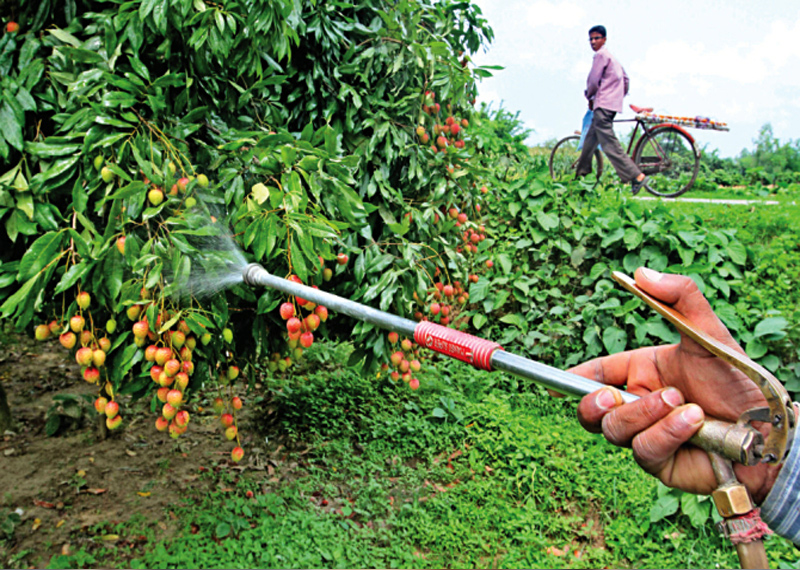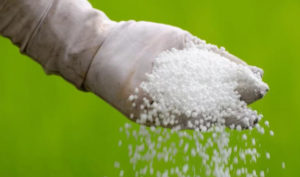
It is a widely recognised fact in South Asia, and particularly in Nepal, that small farmers do not have the resources to buy high-yielding inputs such as fertilizers or other chemicals (pesticides, herbicides) and water. They rely on the inputs that they already have on their farm. One of the main inputs required for high-yield are the nutrients. They are either sourced from the locally-available organic materials, or applied externally. Small farmers usually aim at low yields and rely on locally-available organic materials such as farmyard manure (FYM), composts, or crop wastes and residues in whatever amounts available in their farm. But such materials will not be enough for farmers who want to maximise their yield. The reality is that such on-farm sources of organic materials have low nutrient content which cannot support high yields. For farmers to transition from subsistence to commercial agriculture, applications of inorganic fertilizers become absolutely necessary.
But the transition is not easy. There are several myths surrounding the use of chemical fertilizers and/or organic materials (organic fertilizers). Some sections of the society, particularly the activists or advocates influenced by NGOs or INGOs, the research community, and even government policy-makers and planners have a misplaced notion regarding the use of chemical or inorganic fertilizers. They believe the chemicals adversely affect soil quality and decrease crop productivity. These claims, however, have no scientific basis, and any decline in soil or crop productivity may be due attributed to over-or misuse of chemical fertilizers.
The purpose of this article is to clarify some common myths by providing scientific facts so that the farmers can understand that either the application of organic materials alone or an inappropriate combination of the inorganic fertilizers and organic materials, will not yield desirable results. It is aimed to assist planners and policy makers to develop policies to promote for the rational use of inorganic fertilisers or organic materials (organic fertilisers) for achieving food security for an ever-increasing population and getting rid of poverty.

Myth 1: Organic materials improve the physical properties of all soils
A common myth is that the organic materials (or organic fertilizers) improve the physical properties (i.e., by improving water retention, reducing soil crusting, increasing soil porosity, and reducing erosion) of all soils. The reality is that the organic materials, particularly when used as soil cover or mulch, can improve the physical properties of only aerobic soils. As rice fields are deliberately flooded and puddled, and hence soil structure is destroyed during land preparation, organic materials cannot improve the soil structure of puddled rice fields. However, such improvements may be of importance for direct-seeded rice grown without puddling, or for non-puddled transplanted rice which is now being promoted through conservation agriculture in South Asia, including Nepal.
Myth 2: Organic materials can provide required amount of nutrients for high yield
Another widely propagated myth is that organic materials can provide the required quantity of essential nutrients for high yields. The reality is that organic materials contain minimal amounts of macro-and micro-nutrients. If the nutrients required for high yields are to be supplied through organic materials only, they would be needed in voluminous amounts to supply required amounts. For example, the commonly-used fertilizer urea contains 46% N (nitrogen) whereas FYM contains 0.5-1.0% N. Around 20 kg N would be required to produce 1 ton of rice. So, to produce 5-6 t/ha yield, the rice crop needs about 100-120 kg N. Some of this N will be available through the soil, while the remaining N should be supplied through organic sources or inorganic fertilizers. The exception is that organic materials, especially crop residues (e.g., rice residues), can supply (recycle) considerable potassium (K), sometimes even in excess of crop needs.The integrated use of inorganic fertilizers with organic materials should consequently account for this supply of K from organic materials.
All concerned must remember that large amounts of FYM (or any other organic materials) would be required compared to a small amount to supply the same amount of nutrients to the crop. Such large amounts of organic materials are not available with farmers, or will not be readily available through any other sources. Moreover, the nutrient content of organic materials are highly variable and they release nutrients slowly and at variable rates. Information on the period of nutrient release and on the rates by which nutrients are mineralized for the plants to absorb are not provided to farmers, leading to uncertainties in calculations of nutrients to be supplied through such sources. Further, due to the voluminous amount of organic materials, their handling, transportation, and storage will always be an issue. Thus, organic-only practice will be laborious, costly, and impractical.
Myth 3: Organic fertilizers produce better quality products
One globally spread (and perhaps believed) myth is that organic fertilizers produce better quality products compared to inorganic ones. The reality is that while organic fertilizers may result in better quality products it is not the application of organic fertilizers alone that results in an increase of anti-oxidants (e.g., total phenolic content). Scientific evidence shows that sustainable use of chemical fertilizers without the use of pesticides can result in high anti-oxidants compared to conventional farming with the application of chemical fertilizers and other chemicals. In fact, studies have shown that the polyphenol content (an anti-oxidant) could even be higher in plants applied with inorganic fertilizers as long as no pesticides are applied.
Myth 4: Organic materials are cheaper than inorganic fertilizers
Similarly, many believe that that organic materials are cheaper than inorganic fertilizers. The reality is that inorganic fertilizers are cheaper than organic fertilizers on per unit of nutrient content basis. Inorganic fertilizers have substantially higher nutrient contents (especially N, P, and K, but also other nutrients), and are also readily available to plants. It must be emphasized that it can be cost ineffective to transport organic materials with high-moisture and low-nutrient contents over long distances compared to inorganic fertilizers with high-nutrient contents.
Myth 5: Legumes and green manures obtain all of their N from atmosphere and all N is used
The other myth that is beyond logical reasoning is that, in case of green manure and leguminous crops (e.g., cover crops, legume leaves, twigs, and residues), all of their N content is fixed from the atmosphere and all N is utilised by the crops. The reality, however, is that the N in green manures and leguminous crops is not necessarily fixed from the atmosphere as a good portion of it is absorbed from the soil.Also, when green manures or legume residues are incorporated into the soil, not all their N contents are used by the crops as some N is lost during decomposition or mineralisation. However, exceptional cases occur when crops grown in rotation capture nutrient unavailable to crops and recycle the otherwise lost nutrients back to crops. Crops, weeds, or green manures (grown in rotation with lowland rice) can assimilate nitrate and then recycle the N back to ensuing rice crops through retained biomass. Another case is that of deep rooting shrubs (such as in agroforestry systems) grown on deep soils, which can capture nutrient from below the rooting depth of crops and recycle them back to future crops.
Myth 6: Fertilisers deteriorate soil quality
The other politically-motivated claim is that chemical fertilizers deteriorate the quality of soil by altering their physical properties and making them acidic. The general perception among policymakers and researchers is that the declining soil or crop productivity is due to soil degradation that can be attributed to the use of inorganic fertilizers. There is no scientific evidence to say that chemical fertilizers, when applied at optimum rates, have an effect on soil structure or its water holding capacity.
Chemical fertilizers per se do not have a bearing on soil quality. It is only when they are continuously applied in excessive amounts (such as practiced in China) that they may change soil texture and result in soil acidification. In Nepal, with some exceptions, the current use of chemical fertilizers is too low, and thus soil acidification or changes in soil texture cannot be expected for many years in future.
Myth 7: Chemical fertilizers provide only a few macronutrients and not micronutrients
Many people believe the chemical fertilizers provide only a few macronutrients and not micronutrients. The reality is that while most organic materials contain some micronutrients by nature, there are now several commercially-available inorganic fertilizers that contain micronutrients. Thus, soil deficient in micronutrients can now be supplied with a smaller amount of inorganic fertilizers containing micronutrients rather than large amounts of organic materials required to supply the same quantity of nutrients for plants.
Myth 8: Organic materials build up soil organic matter irrespective of amounts applied
One popular claim by advocates of organic materials is that organic materials build up soil organic matter (SOM) irrespective of the amounts applied. Organic materials, no doubt, supply nutrients and energy for soil organisms that help in accumulating SOM in soils, their contribution to SOM build-up within a short period of time (e.g., one or two years) is widely misperceived or over-exaggerated.The reality is that large quantities of organic materials would be required to build up SOM. Moreover, the amount of SOM formed with the addition of organic materials depends on the carbon-nitrogen ratio (C:N ratio) of the original materials and conditions during decomposition, and build-up of SOM occurs only in non-flooded or aerobic soils and not significantly on flooded or anaerobic soils. The magnitude of increases in SOM due to the addition of organic materials would be far less than what many advocates of organic fertilizers claim.
Myth 9: It is always safe to apply huge amounts of organic materials on all soils
Advocates of organic fertilizers claim that it is always safe to apply huge amounts of organic materials on every soil, irrespective of the SOM status. The reality is that excess organic materials could cause zinc and sulfur deficiency especially when the field is continuously flooded. Hence, when the SOM is relatively high (>4.0%), manures preferably should be applied in the dry season or aerobic conditions. Further, an increment in toxicity that can be attributed to the anaerobic decomposition of organic materials (such as organic acids and hydrogen sulfide) in flooded soils could also be a concern.
Myth 10: Biofertilizers contribute a significant amount of nutrients to the crop
Advocates of biofertilizers(or microbial fertilizers) claim that such fertilizers contribute a significant amount of nutrients to the crop and can be used in any crop and for all types of ecosystems. Microbial fertilizers can increase the number of microorganisms and accelerate certain microbial processes such as atmospheric N2 fixation, phosphate solubilisation, or cellulose degradation.Biofertilizers are applied to seeds, to soils in the seedbed, or to composting materials. Soil organisms (bacteria, fungi, algae, actinomycetes, earthworms) are essential components of the soil, contributing to soil productivity. There are aerobic and anaerobic N2-fixing bacteria (e.g., Rhizobia fix atmospheric N in roots of leguminous plants) and some bacteria and fungi (e.g., Trichoderma) are effective in decomposing or mineralising SOM, thus helping farmers dispose farm waste and use these to improve soil productivity.
However, the reality is that biofertilizers don’t directly contribute nutrients but merely make nutrients available from other sources like atmospheric N2 or SOM. While the role of the biofertilizers has been recognised, there are pieces of evidence that their effects on crop growth or yield have been inconsistent or not as dramatic as claimed by the advocates of biofertilizers. Moreover, since most of the microorganisms in biofertilizers work under aerobic conditions, they may not be effective under anaerobic conditions.
Conditions, where biofertilizers are effective, are not defined properly to guide extension workers and farmers. Hence, it is important that the biofertilizers developers indicate the presence of species or strains of organisms (whether aerobic or anaerobic) and the conditions where the product is effective.
In addition, there are two important concerns in using organic materials (or organic fertilizers). One is that raw organic materials may contain pathogens especially when these are from manures, including human faeces. Another is the level of heavy metals especially when the raw materials are industrial, or urban or even household wastes.Bags containing organic fertilizers should be properly labeled providing a guarantee that these are free of pathogens and that the contents of the heavy metals are within the acceptable levels.
In conclusion, based on the available scientific evidence, the most practical strategy for farmers would be the application of the organic materials and inorganic fertilizers at a ratio of 25:75 to supply nutrient requirements for high yield and to obtain yields comparable to that from inorganic fertilizers alone.However, even for the application of this suggested amount, the type, quality, content, release pattern and residual effect of nutrients from the organic materials, as well as the availability and practicality of application of those materials need to be considered. The benefits of inorganic fertilizers, when applied in optimum doses, have been well documented but such documentation is lacking for organic materials.
Before rationally promoting the organic materials (or organic fertilizers) to farmers, an inventory of available organic sources of nutrients across the country must be prepared as a high policy priority. Likewise, appropriate and scientifically well-designed field experiments must be conducted across climate, soil types and seasons in Nepal to determine the soil and environmental conditions where organic materials can be effective and be promoted.
The author is Principal Research Fellow, University of Melbourne, Australia & Adjunct Professor, Agriculture & Forestry University, Chitwan, Nepal. Views expressed are personal.




















